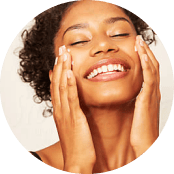
Our skin is an incredible organ, and yet it can often cause much frustration and confusion, especially when it comes to conditions like rosacea and acne. These two skin conditions share some similarities, which can make it challenging to distinguish them.
In this blog, we’ll explore both of these skin conditions, including the signs and types, to help you identify which one you’re experiencing and find the right treatment. We’ll also take a look at our prescription rosacea and acne treatment here at MiQuest and learn more about how they work to restore clear and blemish-free skin. So, is it rosacea or acne?
Rosacea
Rosacea is a common chronic skin condition that primarily affects the face. Most often seen in adults between the ages of 30-50, it can be both physically uncomfortable and emotionally distressing, impacting one’s daily life and confidence. Understanding rosacea is essential for effectively managing its symptoms and improving skin health.
Signs of Rosacea
There are many common signs of rosacea, including:
- Persistent redness across the nose, cheeks, forehead, and chin
- Swelling and inflammation
- Visible blood vessels
- Acne-like breakouts
- A burning or stinging sensation on the skin
- Dry, rough, and scaly skin texture
- Eye irritation and dryness
Types of Rosacea
Rosacea can be categorised into four main types depending on the signs:
- Erythematotelangiectatic Rosacea: This type of rosacea is characterised by facial redness, flushing, and visible blood vessels.
- Papulopustular Rosacea: Often mistaken for acne, this type includes redness, swelling, and acne-like breakouts.
- Phymatous Rosacea: This type involves skin thickening and a bumpy texture. It commonly affects the nose.
- Ocular Rosacea: This type affects the eyes, causing redness, irritation, and swollen eyelids.
Acne
Acne is another common skin condition that occurs when hair follicles become clogged with oil and dead skin cells. Affecting people of all ages, it usually appears on the face, neck, chest, back, and shoulders. The severity of acne can range from mild, with occasional breakouts, to severe, with persistent, painful cysts and nodules.
Signs of Acne:
The most common signs of acne include:
- Blackheads and whiteheads
- Red, inflamed pimples and pustules
- Painful cysts or nodules under the skin
- Excess oil on the skin
- Scarring and hyperpigmentation
Types of Acne:
The main types of acne are also categorised depending on the signs, and include:
- Comedonal Acne: Characterised by blackheads and whiteheads.
- Inflammatory Acne: Includes red and swollen pimples (papules) and pus-filled pimples (pustules).
- Cystic Acne: Severe acne characterised by painful, deep cysts or nodules under the skin.
- Hormonal Acne: Often appears around the jawline and chin, related to hormonal fluctuations.
Understanding the distinct signs of rosacea and acne is crucial for proper diagnosis and treatment. By recognising these signs, you’ll be able to tell the difference between the two conditions and access the right treatment to effectively manage the condition.
Can You Have Rosacea and Acne at the Same Time?
It’s unlikely you would have both rosacea and acne simultaneously. But it’s not impossible. Due to their overlapping symptoms, such as red, inflamed skin and pimples, the conditions are often misdiagnosed for one another.
The underlying causes of rosacea and acne differ, meaning they need distinct treatment approaches. Here at MiQuest, we’re proud to formulate personalised and highly effective prescription cream for rosacea and prescription acne treatment, designed to restore a clear complexion and your skin confidence.
Prescription Treatment for Rosacea and Acne with MiQuest
Here at MiQuest, we’re proud to be changing the future of skincare. Our prescription treatments using active ingredients are made to directly address the specific needs of rosacea and acne, restoring your skin’s natural health and radiance.
Prescription Cream for Rosacea
Our rosacea cream for the face combines niacinamide and metronidazole. Niacinamide helps to reduce redness and inflammation, while metronidazole, an antimicrobial, targets the bacteria associated with rosacea to soothe the skin and prevent flare-ups.
Prescription Acne Treatment
Our prescription acne removal cream uses a combination of tretinoin, niacinamide, and clindamycin. Tretinoin helps to unclog pores and prevent new acne lesions, niacinamide reduces inflammation and improves skin texture, and clindamycin, an antibiotic, helps to kill acne-causing bacteria.
Both of these bespoke treatments work to improve skin health by addressing the root causes of rosacea and acne, ensuring clearer, healthier skin over time.
Conclusion
Determining whether you have rosacea or acne can be challenging, but understanding the differences is key to finding the right treatment. Rosacea often presents with persistent redness and visible blood vessels, while acne is characterised by various types of pimples and clogged pores. Although rare, having both conditions is possible and requires careful diagnosis.
Here at MiQuest, our specialised treatments are expertly tailored to the unique needs of your skin. Whether you're struggling with rosacea or acne, our prescription treatments are designed to help you achieve clearer, healthier skin.
Don't wait—get in touch with us today for more understanding and learn how to treat your skin condition the right way.






AI-Empowered Dermatology, Personalised For You.






